Meteor Dreams
by Mike Hankey, under Mason Dixon Meteor
Ever since this meteor thing started I have been having dreams about meteors. They aren’t always the same dream, they seem to be different. I wake up and say wow that was a cool dream but I can never remember them. I can only remember one meteor dream I’ve had and that’s because I really thought it through and played it back in my head a few times right after I woke up. I’m running through a field with my wife and kids and there are giant meteors falling from the sky and hitting the ground all around us. We are running to get away from being hit, I’m scared. I remember seeing a 6 foot tall meteor lying on the ground and thinking get me the hell out of here — I don’t want anything to do with that!
I headed up to search zone orange after work tonight and a friend of mine sent me a text that said:
I had a dream early this morning around 4:am. We found a piece of the meteor. All I can remember is it was near a fence just off a busy road. Crazy right?
Needless to say I was looking at fences as I patrolled all the roads in the search area.
I have cut up the entire search area into 5 zones: green, yellow, blue, orange and red. The areas are primarly based on public street boundaries and logical lines along the path of the meteor between the 10km and 5km altitudes. East of the trajectory line are zones that encompass areas suggested by Marc Fries to have meteorites of various sizes based on weight. Smaller sized meteorites would have blown farther east while larger rocks would be closer to the trajectory line, but still east of it. I have included zones south and west of the lines as there is a margin of error in the data we have and it is important to cover areas on both sides of the trajectory to compensate for inaccuracies of the data provided. Marc and Rob stressed to me that these areas are estimates based on the data we have about this thing. They are not exact, but rather the best information we have to go on at this point in time. Special thanks to Marc Fries for developing the dark flight model. Marc I am in awe of your kung fu skillz.
Currently the highest priority zones are red and orange. I will be posting more detailed annotated maps as soon as I have the time to put them together.
I only had a couple of hours to search tonight so I went right to the orange zone where the largest rocks (if there are any) would most likely be found. Needless to say I didn’t find any, but I did have a great talk with the land owner and he let me search right there on the spot. He said I could come back as much as needed so long as I respected the land and stayed out of the crop areas. He said I could search those in 3 months when the harvest was completed.
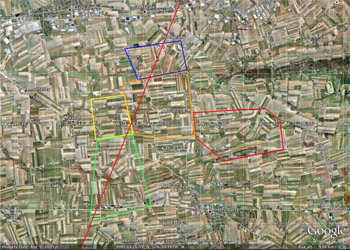
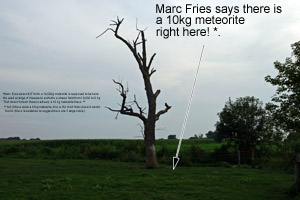

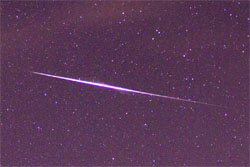
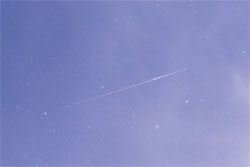
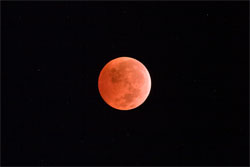


August 11th, 2009 on 11:21 am
Ugh – I did NOT say there was a 10kg meteorite right there! I plotted the fall locations due to wind deflection of a range of meteorite masses from 0.1g up to 10,000g in 10x steps. That defines the expected shape of the strewn field and makes a guess at the location, but it doesn’t necessarily mean that there is a 10kg meteorite in there. (I don’t think hunting for 0.1g meteorites is a good use of time, either!). The important point is how far off the ballistic fall line the ~1,000 down to 10g fragments should fall – knowing this simplifies the search quite a bit. Good luck and keep us posted!
August 11th, 2009 on 11:24 am
That tree does look like it needs the attention of a bulldozer, though – a 10 kg meteorite at terminal velocity would have done the trick pretty thoroughly!
August 11th, 2009 on 6:05 pm
I think you’re off by a couple inches.
Your rocker, that is.
August 11th, 2009 on 10:41 pm
people have been telling me that my whole life. its worked out pretty good so far.
August 11th, 2009 on 11:04 pm
My rocker comment was aimed at Fries. Oops, guess I missed. Maybe I’m using the same software he’s using to pinpoint this meteorite. Ha!
August 12th, 2009 on 1:21 am
Care to elaborate?
August 12th, 2009 on 10:35 am
Marc, no disrespect intended here. Just kidding around about the rocker. But it would be nice if we had an error estimation along with your predictions. The general public, with whom you and Hankey are generously sharing your data, have no idea that computer models usually come with a disclaimer of some kind, “this data is good plus or minus X number of feet or miles or whatever”. I think many people have been treating the results of these computer models as though they are more accurate than they really are and it’s possible that this kind of confusion is translating into field workers focusing too narrowly upon small sear
August 12th, 2009 on 11:23 am
…search regions rather than trying to search in a more “statistical” way – searching more widely along sample routes, for example. I’m not faulting your computer program, but it would be nice to see a list of assumptions that have helped make your predictions and to know that, for example, if one input is tweeked, say, one degree, how will that affect the outcome of the prediction? Is the error circle a matter of feet, miles, or tens of miles? Is the error zone shaped like an ellipse, a circle, or what? What happens to the outcome, for example, if Hankey’s photo is not of the main body but is a large chunk that has broken off on its own? How sensitive are your models to, say, a 5 or 10 percent change in aerodynamic drag coefficients? The corn belt around Lancaster is vast, littered with iron, and what is not an impenetrable sea of crops, dairy cows, and dung is a dense craggy forest littered with slag piles and spent shotgun shells. Not counting Antarctica, I’m going to bet Lancaster county is one of the most difficult places in the world to find a meteorite, so your computer model is essential – and I thank you for your stellar efforts on this. My only gripe is that the fundamental nature of the data needs to be explained to the general public so they understand what these lines and map points really mean. Because of your familiarity with scientific data, you know instinctively that these lines only represent the center of a blob, etc., but the rest of us are prone to thinking they are really, truly the end of a rainbow. I think it would help the situation if we had a error bar here and there. Thanks again, and my apologies if I sounded too harsh about your being off by a couple inches.
August 13th, 2009 on 2:01 pm
No worries; tongue-in-cheek doesn’t show up well in email and blog comments. The reason I haven’t assigned a probability ellipse or what-not to the fall location is that the uncertainties themselves aren’t very well quantifiable. Assessing all the variations in pointing direction, video image distortion, eyewitness account variation, etc etc etc would probably be more time consuming than just searching the ground itself. Plus, I wouldn’t put much stake in the result just because it is so complex. The important point to take from the wind-drift model is this – winds at the time tend to “push” any meteorites to the east of the fall line, apparently by about a half-mile (almost a km) for the 100-1,000g masses. The actual point on the map is a guideline only, not some sort of pirate-map X.